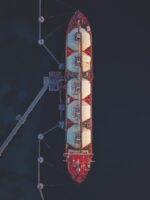- Transport over the seas
- > In recent decades shipping has become the backbone of international trade. More and more goods are being transported from one continent to another by ship. But this growth also has a downside. Exhaust emissions from ships pollute the air and accelerate climate change, while noise, sewage, garbage and invasive species put pressure on marine ecosystems. New, environmentally sound solutions are needed as quickly as possible.

A key industry under pressure
In recent decades, international merchant shipping has been geared towards continuous growth. Larger, faster, always more. This has been the motto of the industry that transports between 80 and 90 per cent of all goods traded worldwide, making it the backbone of our global consumer society. For a long time, the climate and environmental impacts of this development were simply accepted. The industry’s key role and the steadily growing importance of shipping for global production and supply chains made this possible.
But with the signing of the Paris Climate Agreement and increasing global awareness of the environmental and climate impacts of the transportation industry, maritime shipping now stands at a crossroads. Its highest regulatory body, the International Maritime Organization (IMO), has set a target to cut the greenhouse gas emissions of the merchant fleet in half by 2050, as compared to the emissions in 2008. Carbon dioxide emissions in particular are to be reduced by 70 per cent.
Operational adjustments such as reduced cruising speed and regular hull cleaning have a tangible fuel-saving effect, but these alone are not sufficient to achieve the emissions goal. A radical transformation of the entire industry is necessary. What is needed initially is major investment in the development of new propulsion systems and alternative fuels to replace the hitherto prevalent heavy fuel oil and marine diesel oil. Ammonia and hydrogen currently appear to be the most promising alternative fuels, but practical solutions for their use in maritime shipping are still lacking. The next step is to equip the fleet with the new technological systems or to replace it from scratch, a process that will also cost a lot of money.
Globally uniform regulations, a supranational tax on greenhouse gas emissions, and strict controls by the flag and port states are vital in order to substantially boost research and development activities and provide investors with the planning security they so vitally need.
At the same time, coastal nations are facing the challenge of protecting their ports from the consequences of advancing climate change. In view of the rising water levels and the increasing frequency of extreme weather events in the future, the highest priority attaches to protective measures designed to mitigate the impacts of storm, flooding and extreme heat events.
Intensive efforts are also being made to combat the growing problems caused by coastal erosion. Some leading international ports like Rotterdam are developing their own climate goals and strategies to drastically reduce the high greenhouse gas emissions of all their port operations and all associated industries.
In addition, the direct environmental impacts of shipping, such as pollution by exhaust fumes, solid waste, liquid effluent and noise, and the issue of invasive species are gaining more attention. Some of these issues have already been recognized for decades and are being progressively addressed through international regulation. Scientists are just beginning to discover others, however. Noise pollution by shipping traffic, for example, has much broader consequences for the marine environment than was previously known.
The danger of collisions with large marine mammals is also comparatively new on the agenda. A number of studies suggest that anticipatory planning of routes in combination with slower speeds in areas of high animal density will be the most successful strategies.
